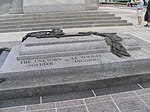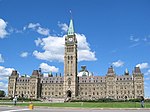Confederation Boulevard
BoulevardsNational Capital CommissionNational Capital Region (Canada)Roads in OttawaState ritual and ceremonies ... and 1 more
Streets in Gatineau
Confederation Boulevard (French: Boulevard de la Confédération) is a "ceremonial and discovery route" in Canada's National Capital Region, running through Parliament Hill and encompassing downtown areas in Ottawa and Gatineau. Some of Canada's most important institutions and landmarks lie along its route. During state visits, Confederation Boulevard is toured by foreign dignitaries. On Canada Day, much of Confederation Boulevard is closed to cars. Confederation Boulevard is an initiative of the National Capital Commission (NCC).The route's name commemorates Canadian Confederation.
Excerpt from the Wikipedia article Confederation Boulevard (License: CC BY-SA 3.0, Authors).Confederation Boulevard
Elgin Street, (Old) Ottawa Rideau-Vanier
Geographical coordinates (GPS) Address Nearby Places Show on map
Geographical coordinates (GPS)
| Latitude | Longitude |
|---|---|
| N 45.42458 ° | E -75.69564 ° |
Address
Pont Plaza Bridge
Elgin Street
K1P 1C7 (Old) Ottawa, Rideau-Vanier
Ontario, Canada
Open on Google Maps







